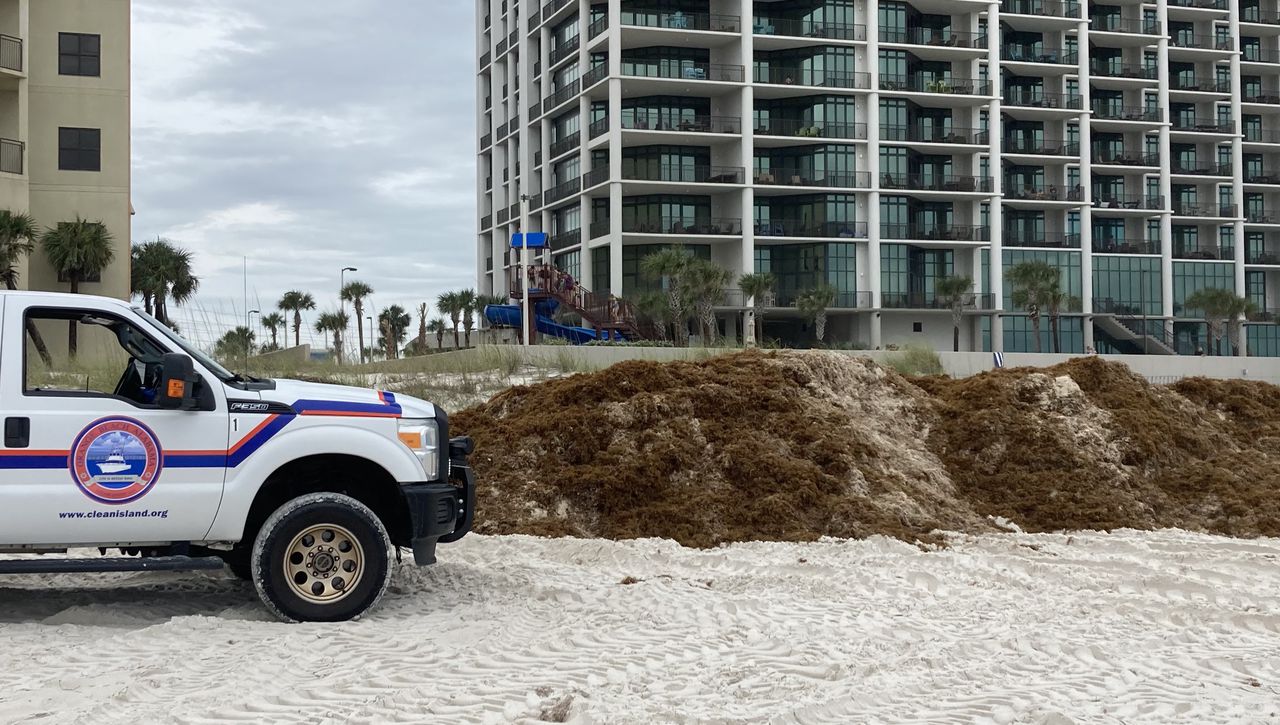Massive sargassum seaweed bloom no threat to Alabama beaches this spring break
An enormous floating seaweed bloom is expected to enter the Gulf of Mexico this month, and could reach Alabama’s beaches sometime this summer.
A clump of sargassum 5,000 miles across is making its way from Africa through the Caribbean Sea, and some of that giant mat of muck could make its way up the northern Gulf.
Brian LaPointe, a research professor at Florida Atlantic University’s Harbor Branch Oceanographic Institute, told NBC News that the current sargassum bloom they are tracking is the second largest ever recorded and will likely continue to grow.
“It’s incredible,” LaPointe said. “What we’re seeing in the satellite imagery does not bode well for a clean beach year.”
The sargassum can build up on beaches and create an unpleasant smell as it breaks down, releasing a chemical called hydrogen sulfide that can be harmful to people with respiratory problems.
But the potential impact on Alabama and northwest Florida’s beaches is still uncertain.
Dauphin Island Sea Lab marine educator Mendel Graeber said that just because a massive bloom moves into the Gulf doesn’t necessarily mean that the mat will cause problems for coastal Alabama. Things like major storms and currents can impact the amount of seaweed that makes it up the Gulf.
“There’s a chance that some of it will end up washing up on our beaches, but at this point, we can’t really predict that,” Graeber said.
Orange Beach Mayor Tony Kennon told AL.com that sargassum can cause big problems for the beach towns when it builds up.
“Nobody wants to be on the beach, or walk to the water from the beach, with ankle-high, four or five inches of grass all around you.
“It has a stench to it as well, so we spend a lot of money trying to keep the beaches clean.”
But while the sargassum can be unpleasant when it comes in giant masses, Graeber said it is a natural and valuable part of the beach ecosystem in Alabama.
“Much of the bottom of the Gulf of Mexico is sand,” Graeber said. “So there’s not a lot of structure. And sargassum is a is a significant source of structure for a lot of animals that attach to it and live in the shelter of these floating mats.”
That includes popular fishing targets like mahi mahi and swordfish, as well as young sea turtles. Then, when it washes up on shore, the sargassum helps stabilize beaches, fertilize sea oats and provides habitat for insects and small crabs that are food for birds and other species.
“This floating seaweed is very important in the Gulf of Mexico,” she said. “So I think that it is important to make the point that it is a valuable part of our coastal and Gulf ecosystems.”
Part of the problem now is that the amount of sargassum in the oceans has increased dramatically in the last 15 years or so.
For more than a decade, scientists have noted significant increases in the amount of sargassum in the Atlantic, beginning in January and continuing through the summer. The mats generally form off the coast of Africa and migrate west, driving by ocean currents until they reach the Americas.
This year’s bloom is currently approaching Key West and other tropical locations, but is expected to drift over into the Gulf of Mexico in the coming months. Some beaches in Mexico are bracing to receive as much as three feet of sargassum in the coming weeks.
Phillip West, Orange Beach’s director of beach operations, said last year the city experienced a significant bloom around Memorial Day. When the blooms do arrive, the city treats it as an “all hands on deck” situation, using all available equipment and manpower to clear the beaches.
The algae is raked or scooped up with tractors and deposited in the sand farther up the beach. Crews then bury it in sand and allow the decomposing sea grass to feed the sea oats and build up sand dunes.
If it ever got too bad for city crews to handle, West said the city has a contractor it uses in case of emergencies like severe storms that it could use to clean the beaches, but that would cost “hundreds of thousands of dollars, potentially.”
